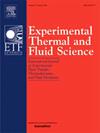均匀流动中矩形棱镜绕流的阻塞效应
IF 3.3
2区 工程技术
Q2 ENGINEERING, MECHANICAL
Experimental Thermal and Fluid Science
Pub Date : 2025-07-17
DOI:10.1016/j.expthermflusci.2025.111567
引用次数: 0
摘要
采用时间分辨粒子图像测速系统,实验研究了阻挡比对矩形棱镜周围流动的影响。测试了三种不同堵塞比(BR = 2.5%, 5%和10%),固定的流向展弦比(AR = 3)和7500雷诺数。结果表明,当BR = 2.5%时,从棱镜前缘分离的剪切层直接脱落到尾流中,而BR的增加促进了棱镜表面的再附着。随着堵塞比的增大,一次、二次和尾流再循环气泡的流向范围减小。前缘附近存在明显的正、负雷诺剪应力区域,过渡界面随着BR的增大而向上游移动。湍流产生主要集中在切变层附近,峰值强度随着BR的增大而增大,并向上游移动。剪切层的生长速率在重新连接的测试用例中是相似的,而在未连接的测试用例中是下降的。下游湍流结构的空间相干性增加,但BR10的阻塞效应显著降低了空间相干性。雷诺数法向应力的频谱和谱分解表明,堵塞比的增加增加了von Kármán涡旋脱落的优势。对于较高的阻塞比,湍流主要受与旋涡脱落相关的中尺度影响,低频扑动和小尺度剪切层不稳定性的影响较小。相比之下,较低的堵塞比表现出更复杂的小、中、大尺度湍流动力学的相互作用。本文章由计算机程序翻译,如有差异,请以英文原文为准。
Blockage effects on flow around rectangular prisms in uniform flow
The influence of blockage ratio on the flow around a rectangular prism was experimentally investigated using a time-resolved particle image velocimetry system. Three different blockage ratios (BR = 2.5 %, 5 %, and 10 %) were tested, with a fixed streamwise aspect ratio (AR = 3) and a Reynolds number of 7500. The results indicate that, for BR = 2.5 %, the separated shear layer from the leading edge of the prism is shed directly into the wake, however, an increase of BR promotes the reattachment on the surface of the prism. The streamwise extent of the primary, secondary and wake recirculation bubbles decrease with an increase in blockage ratio. Distinct regions of positive and negative Reynolds shear stress manifest near the leading edge, with the transitioning interface shifting upstream with increasing BR. Turbulence production concentrates near the shear layer, with peak magnitude increasing and shifting upstream with BR. The growth rate of the shear layer is similar for the reattached test cases but decrease for the unattached test cases. The spatial coherence of the turbulent structures increases downstream, however, the effects of blockage significantly reduced the spatial coherence in the BR10 case. Frequency spectra and spectral decomposition of the Reynolds normal stresses revealed that increasing the blockage ratio increases the dominance of von Kármán vortex shedding. For higher blockage ratios, turbulence is primarily influenced by intermediate-scales associated with vortex shedding, with reduced contributions from low-frequency flapping and small-scale shear-layer instabilities. In contrast, the lower blockage ratio exhibits a more complex interplay of small, intermediate, and large-scales turbulence dynamics.
求助全文
通过发布文献求助,成功后即可免费获取论文全文。
去求助
来源期刊

Experimental Thermal and Fluid Science
工程技术-工程:机械
CiteScore
6.70
自引率
3.10%
发文量
159
审稿时长
34 days
期刊介绍:
Experimental Thermal and Fluid Science provides a forum for research emphasizing experimental work that enhances fundamental understanding of heat transfer, thermodynamics, and fluid mechanics. In addition to the principal areas of research, the journal covers research results in related fields, including combined heat and mass transfer, flows with phase transition, micro- and nano-scale systems, multiphase flow, combustion, radiative transfer, porous media, cryogenics, turbulence, and novel experimental techniques.
 求助内容:
求助内容: 应助结果提醒方式:
应助结果提醒方式:


